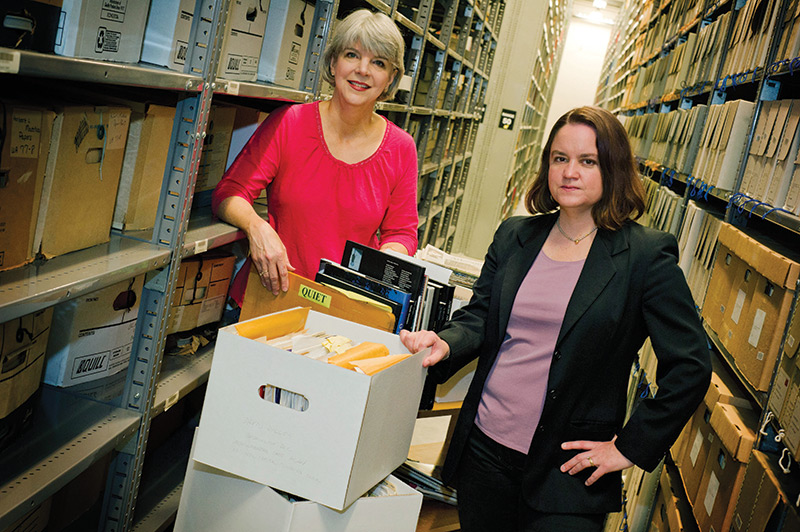“We have very few restrictions, but we do have rules,” he says. “We want to make the collections accessible for everyone.”
But preserving 500-year-old maps can be tricky. Measures taken include storing the documents flat, encased between two sheets of polyester film that are custom-made at the library. (Some of the larger maps are stored rolled, either wrapped around acid-free board tubes or in special boxes.)
Surprisingly, it’s often the newer materials that cause the most preservation issues.
“The ironic thing is that many of the maps with the biggest problems come from the 20th century,” Huseman says. Due to the cheaper, more acidic paper that became popular in the early 1900s, maps from that age can brown and crumble quickly. “Proper housing and storage are critical.”
Even more critical is the preservation of the library’s photographic materials—the millions of negatives, prints, slides, and daguerreotypes documenting the history of North Texas, including archives from the Fort Worth Star-Telegram and from local commercial photographers such as W.D. Smith.
“We have some items—like our acetate negatives from the 1930s, ’40s, and ’50s—that are suffering right now,” says Brenda McClurkin, head of Special Collections.

Brenda McClurkin and Kate Holliday with the David Dillon Papers.
In typical office conditions, film negatives begin to deteriorate after 50 years. Thanks to the University’s new cold-storage vault, however, the collection is getting an extension of about 500 years. Recently completed at the Central Library, the $800,000, world-class vault comprises two rooms that will eventually house roughly 5 million negatives, film reels, and other materials.
“Digitizing these 5 million negatives would be a staggering and expensive endeavor. Cold-storage vault consultants estimated the cost in 2010 to be approximately $100 million,” McClurkin notes. “Stabilizing the negatives in a cold-storage environment will permit them to survive until their digitization can be planned more strategically.”
That digitization is ongoing, with scanning already complete on an estimated 12,000 images. The staff is making arrangements to begin digitizing W.D. Smith’s negatives from the 1940s and ’50s as well, to keep Special Collections’ materials at the public’s ready fingertips.
“We take our role as caretakers very seriously. Our collections were born out of passion for these topics. They've been nurtured, and we feel we have the responsibility to continue nuturing them.”
as we move forward into the 21st century, Special Collections will have to adapt its preservation approaches and treatments for the new, more modern types of materials that are becoming increasingly common in its archives.
A good example of this is the David Dillion Papers, donated to UT Arlington after the death of the revered architectural critic and Dallas Morning News journalist. During his long tenure at the newspaper, Dillon wrote more than 1,000 articles and several books. Consequently, his collection features a huge range of materials, including reporter’s notebooks, edited manuscripts, photographs, and correspondence with editors and readers.
“It’s a wonderful collection,” says Associate Professor Kate Holliday, director of the David Dillon Center for Texas Architecture. “It shows how Dillon wrote about architecture in Dallas and in Texas, which is helpful for anyone interested in the history of journalism, the way journalism has evolved from the 20th into the 21st century.”
The library’s future plans will have to account for the digital preservation of these and another ephemeral forms of media, such as audio recordings. Dillon’s archive features a number of these, as he interviewed Michael Graves, O’Neil Ford, and other noted architects in the 1980s and ’90s.
“Making the recordings accessible to the public is a crucial part of their survival,” Dr. Holliday says.
“We take our role as caretakers very seriously,” adds McClurkin. “Our collections were born out of passion for these topics. They’ve been nurtured, and we feel we have the responsibility to continue nurturing them.”

















